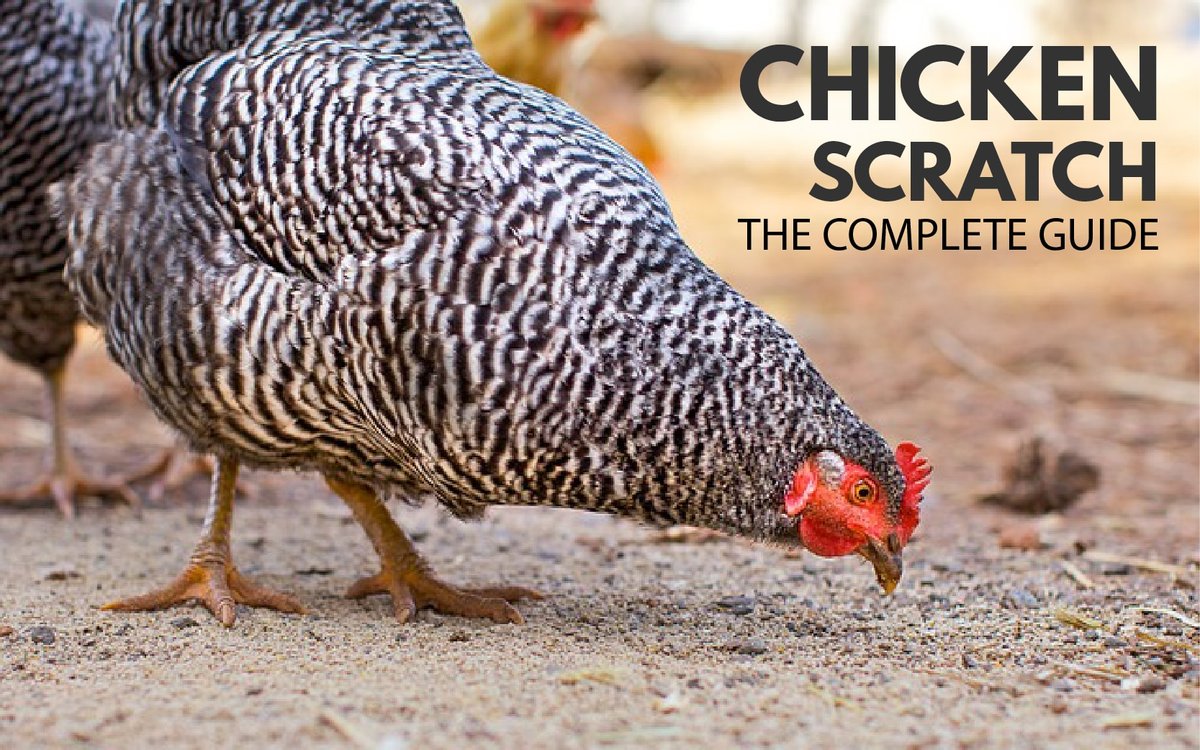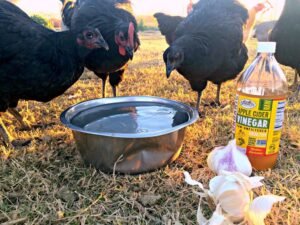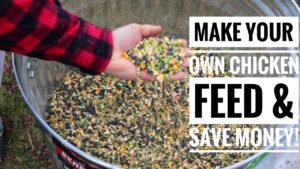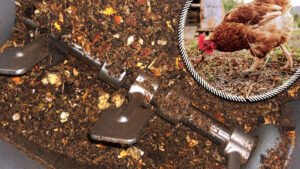Have you ever stood in the feed store, faced with a wall of bags—Starter, Grower, Layer, Pellets, Crumbles—and then a separate bag of “Scratch Grains,” and felt completely overwhelmed? You’re not alone. This is one of the most common points of confusion for new chicken keepers.
The difference is simple, yet critically important for your flock’s health. Think of it this way: Chicken Feed is a complete, balanced meal. Scratch Grains are a fun, high-carb treat—like dessert.
This guide will demystify chicken nutrition, explain the different types of feed for each life stage, and teach you the proper way to use scratch grains without harming your flock’s health.
The Fundamental Difference: A Side-by-Side Comparison
To start, here’s a quick overview of what makes each product unique.
| Feature | Chicken Feed | Scratch Grains |
|---|---|---|
| Purpose | Complete, balanced nutrition | Treat & foraging encouragement |
| Nutritional Value | Contains protein, vitamins, minerals, and calcium. | Mostly carbs (corn, oats, etc.). Unbalanced. |
| When to Feed | All day, every day. It should be their primary food. | Limited amounts, usually in the late afternoon. |
| Analogy | The Main Course | Dessert |
This table highlights the core principle: chicken feed is a nutritionally complete diet designed for your flock’s specific needs, while scratch grains are a supplemental food. The biggest mistake a new keeper can make is confusing the two. Feeding only scratch grains would be like trying to live on nothing but candy bars; it provides energy but leads to serious malnutrition over time.
By keeping this simple comparison in mind, you can ensure your flock’s diet is built on a solid foundation of complete nutrition, leaving the next chapter to dive into the specifics of what that looks like.
A Guide to Chicken Feed: Complete Nutrition for Every Life Stage
Chicken feed is scientifically formulated to contain all the protein, vitamins, and minerals a chicken needs to thrive at a specific life stage. The feed’s ingredients are carefully balanced to ensure your flock gets everything required for proper growth, feather production, egg-laying, and overall health.
Chick Starter (Age: 0-8 Weeks)
This is the most important food you’ll give a baby chick. Chick starter has a high protein content (20-24%) to support the rapid growth of bones, muscles, and feathers. Protein is the building block for their tiny bodies, and without it, they won’t develop properly. You may see medicated and unmedicated options. Medicated starter feed contains a coccidiostat to prevent the common and deadly parasite coccidiosis. Unmedicated starter is an option if your chicks have been vaccinated against coccidiosis or if you prefer to avoid medicated feed entirely.
Grower Feed (Age: 8-18 Weeks)
After the chick stage, your young chickens are now called pullets. Grower feed has a lower protein content (16-18%) than starter and, most importantly, lower calcium levels. The transition from starter to grower is crucial. It’s designed for steady growth, preparing them for egg-laying without putting a strain on their kidneys from excess protein or causing premature development from too much calcium.
Layer Feed (Age: 18+ Weeks or First Egg)
This is the correct food for laying hens. Layer feed contains moderate protein (16%) and a high amount of calcium to ensure strong, healthy eggshells. Chickens laying eggs need this specific calcium boost, as a single eggshell can use up to 10% of a chicken’s total body calcium. Without enough calcium, they will lay soft-shelled eggs or, in severe cases, experience painful egg-binding or bone density loss (osteoporosis). Many keepers also provide a separate dish of oyster shell to give their hens a “free-choice” calcium supplement.
Pellets vs. Crumbles vs. Mash: Does the Form Matter?
While the nutritional content is the same, the form of the feed can make a difference in how it’s consumed.
- Pellets are compressed, cylindrical shapes. They are easy to store and minimize waste.
- Crumbles are broken pellets. They are a good choice for chicks transitioning from starter to a larger feed.
- Mash is a loose, unprocessed powdery mixture. It’s often the most natural form of feed, but it can lead to more waste if chickens scratch through it.
What About Broiler (Meat Bird) Feed?
Broiler or finisher feed is specifically for chickens raised for meat. It is very high in protein and designed for maximum, rapid growth. These are not suitable for your laying flock, as the high protein and caloric density can lead to health issues, obesity, and a shorter lifespan for breeds not designed for rapid weight gain.
An Increasingly Popular Option: Fermented Feed
More and more chicken keepers are choosing to ferment their feed. Fermentation is a process of soaking feed in water for a few days to create a probiotic-rich, living food. This process makes the nutrients more digestible, which can increase nutrient absorption and make the feed more filling. This also helps support a healthy gut flora in the chicken’s digestive system, leading to stronger immune systems and, in many cases, a reduction in the amount of feed your flock consumes daily.
By selecting the right feed for your flock’s life stage and understanding the different forms, you’re setting the foundation for a healthy life. The next step is to understand how to supplement that diet correctly and what to look for if something goes wrong.
All About Scratch Grains: The “Dessert” Course
Scratch grains are a mix of whole or cracked grains like corn, oats, and wheat. While they may seem nutritious, they are essentially empty calories for a chicken. They are a treat, not a meal.
What is the Purpose of Scratch Grains?
Scratch grains have three main roles that benefit your flock’s well-being:
- A high-energy treat: Chickens love the taste of scratch, and it’s a great way to bond with them. It’s a rewarding treat that encourages them to interact with you.
- Encourages foraging: Tossing scratch on the ground encourages chickens to scratch and forage, which is a natural, stimulating behavior. This helps relieve boredom and keeps them active.
- A tool to generate body heat: Because scratch is high in carbohydrates, feeding a small amount in the late afternoon helps chickens generate body heat overnight as their bodies digest it. This is particularly helpful in cold weather.
The 90/10 Rule: The Most Important Rule for Treats
This rule is a core part of keeping your chickens healthy. Treats, including scratch, should make up no more than 10% of a chicken’s daily diet. The other 90% must be their complete feed to ensure they are getting all the essential vitamins and minerals. Providing too much scratch can lead to severe issues like malnutrition, obesity, and a condition called Fatty Liver Hemorrhagic Syndrome, where the liver becomes so fatty it can rupture, leading to death.
Can I Mix Scratch Grains with Chicken Feed?
It’s a bad idea. Mixing scratch with their complete feed is like mixing popcorn into a healthy salad. The chickens will pick out the “junk food” they love, leaving the vital, balanced nutrition in their feed untouched. This “selective feeding” can quickly lead to malnutrition because they will fill up on empty calories instead of the protein, vitamins, and minerals they need. It’s always best to feed scratch as a separate, limited treat.
When is the Best Time of Day to Feed Scratch?
The best time to feed scratch is in the late afternoon, about an hour before they go into the coop to roost. This gives them something fun to do before bed, and the carbs will help them stay warm through the night.
Scratch is an easy and fun way to interact with your flock, but it’s just one piece of the puzzle. Let’s move on to the other critical components of their diet, including the food they find and the supplements you need to provide.
Other Safe Treats & The Role of Grit
While commercial feed and scratch grains are the cornerstones of your flock’s diet, they’ll also love a variety of other treats. The key is to always remember the 90/10 rule.
Safe Kitchen Scraps for Chickens
Most fruits and vegetables are safe for chickens, as well as cooked grains and meat in moderation. Here are some examples of healthy kitchen scraps to offer as a treat:
- Veggies: Leafy greens, broccoli, carrots, cucumbers, pumpkins, and squash.
- Fruits: Berries, apples (without seeds), watermelon, and bananas.
- Cooked Foods: Cooked meat scraps (no bones or excessive fat), cooked rice, and cooked pasta.
- Eggs: Cooked eggs (scrambled or boiled) are a fantastic protein boost.
Foods to AVOID: Never feed your chickens raw potatoes, avocado pits/skins, chocolate, coffee grounds, or anything moldy, salty, or highly processed. It’s also worth noting that some places have legal restrictions on feeding kitchen scraps. For more information, check out our guide on Is It Really Illegal to Feed Chickens Kitchen Scraps in the U.S.?.
The Importance of Grit
Grit is a supplement that every chicken needs, especially if they are eating anything other than finely ground feed. Chickens don’t have teeth. Instead, they have a muscular organ called a gizzard that acts as their “stomach teeth” to grind food.
Grit is simply small, indigestible stones or pebbles that a chicken swallows. These stones are stored in the gizzard and, with the help of strong muscle contractions, they grind up hard foods like grains, seeds, and even fibrous greens. This process makes the food more digestible, allowing the chicken to properly absorb the nutrients from its diet.
For chickens that free-range, they will likely find their own grit in the soil. For confined chickens, you must provide a separate dish of insoluble grit.
Understanding these dietary supplements ensures your chickens are not just eating, but truly thriving. Next, let’s explore how to spot if something is missing from their diet.
Identifying Nutritional Deficiencies
While a quality, balanced feed is the best way to prevent deficiencies, it’s wise to know what to look for just in case. The signs of malnutrition often appear gradually but can become serious if ignored.
Here are some common symptoms associated with nutritional deficiencies:
- Feather Issues: Ruffled, brittle, or abnormal feathers. A lack of certain amino acids or vitamins can lead to poor feather quality and a loss of pigmentation.
- Weakness or Lethargy: Chickens that are weak, listless, or have a reduced appetite may not be getting enough protein, carbohydrates, or key minerals. For more information on this, read our guide on Why Is My Chicken Lethargic? 17 Causes & How to Help.
- Skeletal Problems: Soft or rubbery bones, bowed legs, and lameness can be signs of a calcium, phosphorus, or vitamin D deficiency. This is especially common in chicks and laying hens.
- Reduced Egg Production: A sudden drop in egg-laying or the appearance of thin, soft-shelled eggs is a classic sign of insufficient calcium, protein, or vitamin D.
- Nervous System Issues: Tremors, “stargazing” (head turned upward), or curled toes can indicate a deficiency in B vitamins.
If you suspect a deficiency, the first step is to check your feed’s expiration date and storage conditions. If the feed is fresh and stored properly, you may need to consult a veterinarian or an experienced poultry expert to pinpoint the exact issue.
With this knowledge, you can now not only build a healthy diet but also troubleshoot and spot potential issues before they become serious.
Frequently Asked Questions (FAQ)
Q: Can you give chickens too much scratch?
A: Yes, absolutely. Overfeeding scratch violates the 90/10 rule and can lead to malnutrition, obesity, and reduced egg production because their bodies aren’t getting the nutrients needed to make eggs. This can also lead to more serious health problems like egg-binding and Fatty Liver Hemorrhagic Syndrome.
Q: At what age can chickens have cracked corn or scratch?
A: It’s best to wait until they are fully feathered and eating their regular feed well, usually around 8-12 weeks of age. A chick’s digestive system is not fully developed enough to properly digest the whole grains in scratch, and it’s essential that they prioritize their complete starter feed for proper growth.
Q: How do I make my own chicken feed or scratch?
A: Making your own scratch is easy—it’s just a mix of grains. However, making your own complete feed from scratch is extremely difficult for beginners. It requires precise nutritional calculations to ensure the correct balance of protein, calcium, amino acids, and other vital nutrients. It’s much safer to rely on commercially formulated feeds that are regulated to be nutritionally complete.
Q: Are mealworms good for chickens?
A: Yes, they are an excellent high-protein treat that chickens love. They are a great source of protein, especially during a molt, but they still fall under the 10% treat rule.
Q: Can I feed chicken scratch to wild birds?
A: Yes. Chicken scratch is essentially a basic wild bird seed mix and is perfectly safe for them.
Conclusion: Feed for Health, Scratch for Fun
By understanding the difference between a complete meal (feed) and a treat (scratch), you’re making a huge step toward becoming a knowledgeable chicken keeper. Always provide a life-stage-appropriate complete feed as the primary diet. Use scratch grains and other treats sparingly, following the 90/10 rule. By doing so, you can make informed choices that lead to a healthy, happy, and productive flock.
This complete guide should give you everything you need to confidently feed your flock. Please let me know if you would like to explore any of these topics in more detail, such as the process of fermenting your own feed!

Oladepo Babatunde is the founder of ChickenStarter.com. He is a backyard chicken keeper and educator who specializes in helping beginners raise healthy flocks, particularly in warm climates. His expertise comes from years of hands-on experience building coops, treating common chicken ailments, and solving flock management issues. His own happy hens are a testament to his methods, laying 25-30 eggs weekly.



